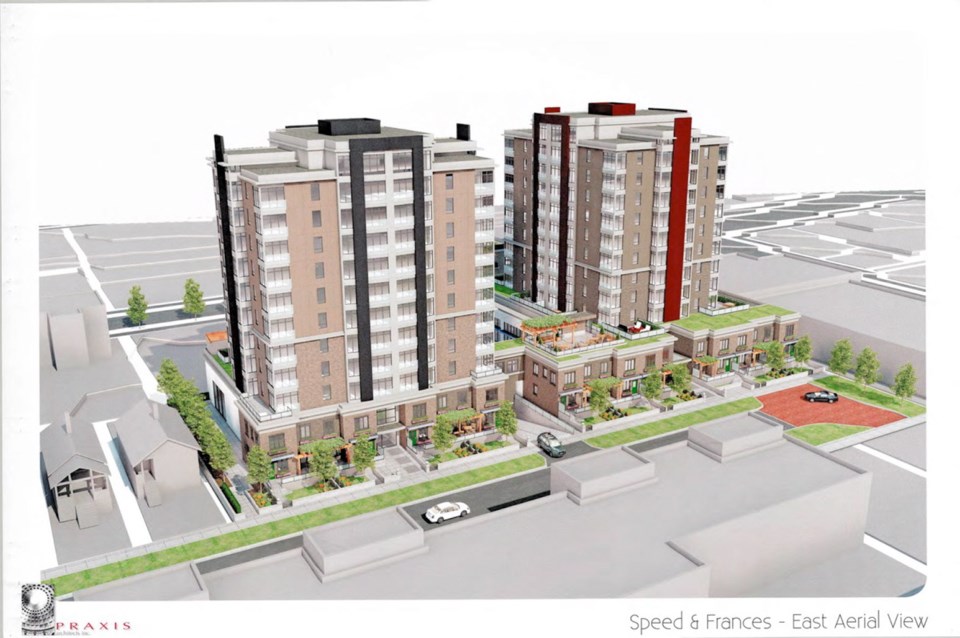The City of Victoria has refused to back down from a requirement for an almost $1-million amenity contribution before two residential towers on industrial/commercial property across from Mayfair Shopping Centre will be allowed to proceed.
In what Coun. Ben Isitt hoped wasn’t playing “a game of chicken” with the developer, Oakwood Parks Estates, councillors stuck with staff recommendations calling for a $975,000 amenity contribution for a proposal to build two 12-storey towers over ground floor commercial on Speed and Frances avenues.
The developer says the project represents a $52-million investment — likely the most significant capital investment in the area since Mayfair mall was built — and will pay future property taxes of about $385,000 a year.
Isitt said it would be helpful if the city had more internal capacity to do its own economic analysis of proposed developments. That way the city would know if it was “asking too much in terms of stalling this project and freezing use of the land for a decade or is this just a game of chicken?”
Isitt said that based on all available reports, the amenity request appeared to be reasonable.
Coun. Marianne Alto urged her colleagues to consider asking for a lesser amount, calling the proposed amenity “unreasonable in the extreme.”
She suggested a contribution of $540,000, which would be a compromise between the staff recommendation and the $335,000 the applicant was proposing to pay.
When the item came up at Thursday evening’s council meeting, Alto noted that the first proposal for this site was before council more than three years ago and included an entire building of affordable housing, which was rejected.
“I have repeatedly been puzzled why it is that we are frustrating what I consider to be quite a lovely and quite an appropriate anchor tenant for the neighbourhood development of Burnside/Gorge,” Alto said.
Council agreed to have staff report back on providing flexibility on when the amenity contribution is made.
The decision came on the heels of council recommending adoption of a new density-bonus amenity contribution policy that sets a fixed rate target of $5 per square foot for amenity contributions when considering additional floor space above the base density allowed in large urban villages or urban residential areas, and $12 a square foot in the downtown core.
However, the new policy calls for third-party analysis to be used as a basis for negotiating amenity contributions for major rezonings in the town centre or for zonings that are from industrial or institutional use to residential or mixed use.
“I hope it doesn’t freeze the land sitting there in limbo for a long time, but I think we’ve just approved a policy. It passed unanimously. So I think it would be helpful if the first foot we put forward supports the decisions coming out of that policy,” said Mayor Lisa Helps.
Victoria’s existing policy requires developers to make an amenity contribution tied to changes in zoning that increase allowable density, which increases the value of the land. In this case, the recommended amenity contribution is equivalent to 75 per cent of the additional value of the land, as determined by an independent consultant.
But Oakwood Parks Estates consultant Deane Strongitharm, in a letter to the city, said the developer believes 25 per cent of the land-lift value — $335,000 (with $75,000 deducted for construction of a public walkway) — would be more appropriate.
Strongitharm said this project is high risk as it is located in a neighbourhood in transition and facing some challenging site conditions.
“Given the risk, the developer’s profit should be 20 to 25 per cent, but the land-lift report undertaken used 15 per cent; the commercial space in the project is viewed as being a liability rather than a positive cash flow contributor,” Strongitharm said.
In a later interview, Strongitharm said it is positive that the city is willing to look at when the payment is to be required to be paid. But he said the cash amenity requirement is significant, “more, I think, in cash than any other project that I’m aware of in the city.”



